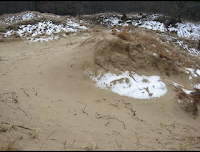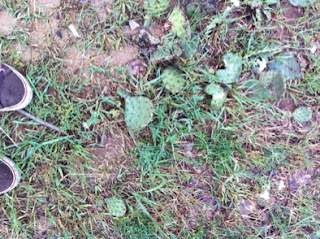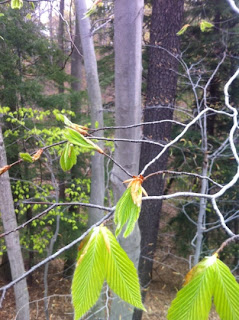

My park is a substantial amount of land that borders part of the lake. From being at my park when it was snowing to now being there in the morning sunshine with the dew still on the leaves is an amazing change. When I first started going to my park I disliked it because there wasn't much going on just dead silence and ringing in my ears. Occasionally there would be a squirrel running around scavenging when the weather got above the freezing point like it often did. At this point I would be walking through slush with my partner trying to identify things like erosion, global climate change, and hibernation. Walking out of my park every week with wet muddy shoes wasn't the best or most exciting thing, but it started to grow on me. I enjoyed my wednesday mornings being able to go to my peaceful park seeing it grow and change because God was working his
magic in there. I wish now I would have been able to take time lapse pictures of one area to see the snow melt the trees start to look "happier", then bud up and pop out leaves. The last park visits were the best find animals like a snake and even seeing some deer in the park for the first time not just the footprints. My view point on parks now have some depth and I have a reason to be grateful for them not just see them as a waste of space that we should just build over anyway.




Flooding in the long run might be good for the park. It could prevent the wildfire that my park experienced during the early spring. It would kill off a lot of the little seedlings and it would move the dead leaves or at least wet them down and increase decomposition. Flooding always seems like a bad thing whenever it happens just because of the destruction, but in the long run it can be a good thing.
My park which was last appraised in 2009 was worth 32-39 million dollars. Saugatuck dunes, my park, has a huge amount of value and with the felt mansion sitting on it, it gains sentimental value. This mansion was completed in 1928 by an inventor named Dorr E. Felt. This building has been through a lot. It has been a summer home then a school and eventually a minimum security correctional facility. This land has a lot of face value and a lot of value to people who know and embrace its history. For me if I had the billions of dollars that the owner Aubrey McClendon has then I would pay the whopping $350,000 in taxes it costs just to pay for the park. This is just the taxes it doesn't include the cost of the upkeep or employees. This park is definitely worth the price because it is a great piece of land and it could almost be considered a protected park. It is a safe haven for animals and for people with less resources to go and get away for a bit while walking the multiple paths.
Throughout the months I have been to the park with my partner Austin Vanderlaan we have both seen God changing our park and giving us chances to really dive into what our park had to offer us. One of the greatest things I will remember is being able to pick up a snake and examine it.
 God has been changing our park from the time we set foot in it to our last visit to the park. In the early stages God gave the park snow and gave the trees the ability to pull all their sap back down to their roots so they do not explode when it freezes outside. Also God gave the park a diverse amount of plants and trees
God has been changing our park from the time we set foot in it to our last visit to the park. In the early stages God gave the park snow and gave the trees the ability to pull all their sap back down to their roots so they do not explode when it freezes outside. Also God gave the park a diverse amount of plants and trees
These are only a small amount of the diversity in trees my park has to offer. With all these different trees the wooded areas can supply many different types of animals as well. With these animals come their predators and this allows the food pyramid to build and grow.
 God is absolutely magnificent with the changes in the park. He has the trees bud and them some bloom while the others are popping their leaves out like a butterfly coming out of its cocoon. My park must be a magnificent sight to see in the fall with all the different colors and the amount of leaves on the trails must be insane. This spring there was a forest fire in my park and from all the science classes I have taken I have learned that from forest fires comes new life. Out of forest fires there is one tree that grows this tree is the Jack Pine. The DNR intentionally lights fires around these trees to allow the pine cones to crack and release their seeds from the heat. Also from this unique tree there is a bird that will only nest under a newly grown jack pine. This bird is the Kirtland Warbler. This is one of the example where we see God bring good out of the bad.
God is absolutely magnificent with the changes in the park. He has the trees bud and them some bloom while the others are popping their leaves out like a butterfly coming out of its cocoon. My park must be a magnificent sight to see in the fall with all the different colors and the amount of leaves on the trails must be insane. This spring there was a forest fire in my park and from all the science classes I have taken I have learned that from forest fires comes new life. Out of forest fires there is one tree that grows this tree is the Jack Pine. The DNR intentionally lights fires around these trees to allow the pine cones to crack and release their seeds from the heat. Also from this unique tree there is a bird that will only nest under a newly grown jack pine. This bird is the Kirtland Warbler. This is one of the example where we see God bring good out of the bad. Renewing and bring life out of destruction are great reflections of Gods character in my park. They show how he can be powerful, but grow beautiful things out of that destruction that wouldn't normally be there. Also bringing life out of the ground refers back to the creation story where God made man out of dust. It is a unique thing even with trees. Dust to life back to dust and this is the way of humans as well.
Weathering and Erosion have been a big part of my park during the summer months so far. You can see this in the trails and you can see the moss being more prominent on the trees. Also even through the potential pollution you can see that summer is here. The boogie board is a pretty good representation. Summer games are even being played around my park like frisbee golf there are marks in the sand representing that people have been there recently to play a round. Also me and Austin have seen these people walking around having fun in the sun.
Also there is a lot of fungus in our park we found some growing on the trees.
Also there is a lot of fungus in our park we found some growing on the trees. I cant wait to sit out at night and watch the bat, the one bat my park has eat bugs at night. Also I cant wait to go out and use my baseball bat to hit baseballs around with Austin!





































